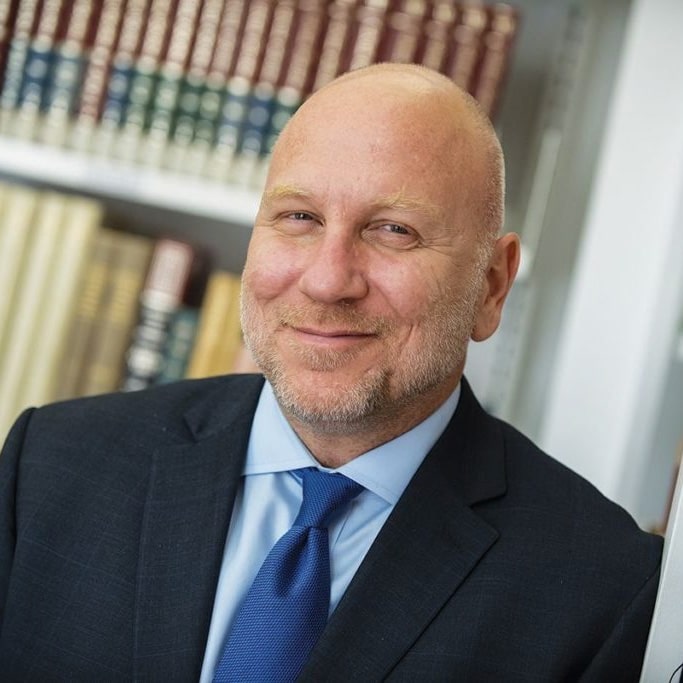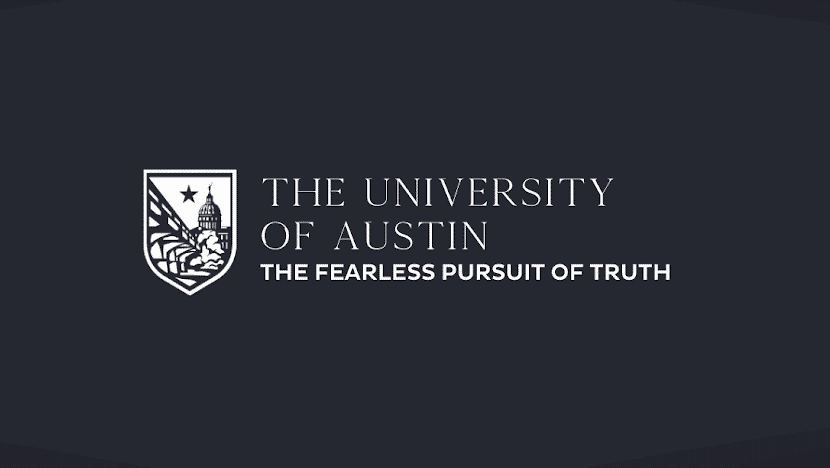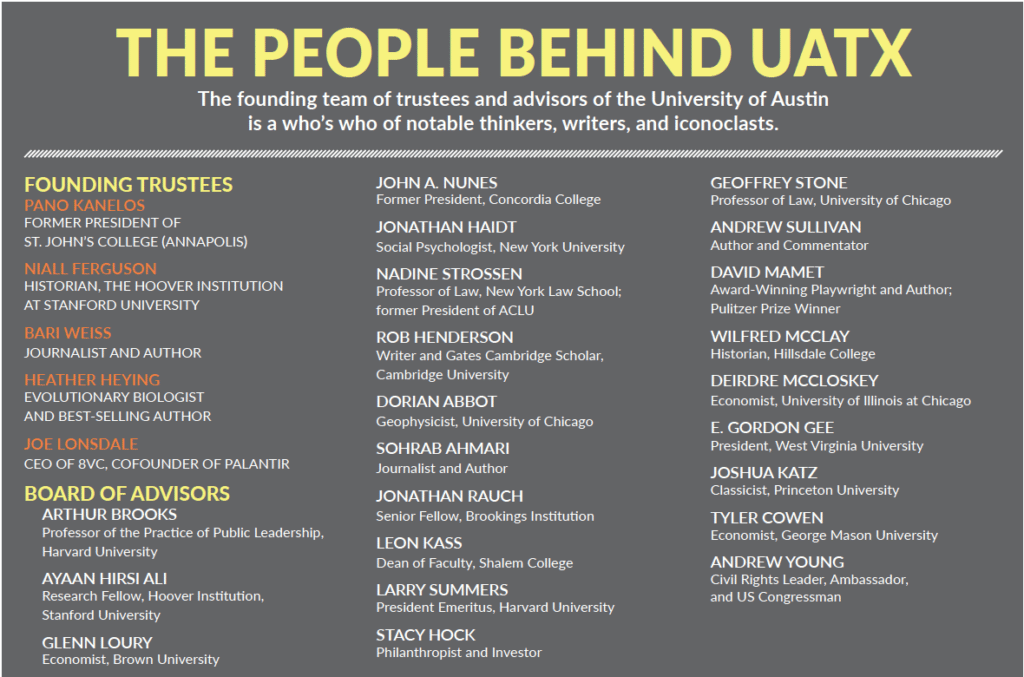Higher Education Is Broken. Can The University of Austin Offer a Better Model?

In November of last year, Pano Kanelos, former president of St. John’s College in Annapolis, announced a new venture on one of the most influential media platforms around today: the Substack newsletter of journalist Bari Weiss.

This new venture was the University of Austin (UATX), designed explicitly to counter current norms in higher education. “Universities no longer have an incentive to create an environment where intellectual dissent is protected and fashionable opinions are scrutinized,” wrote Kanelos. UATX positions itself as a much-needed corrective: a place where both students and faculty are encouraged to fearlessly pursue truth, engage in debate, and banish the censorship—of self and others—that some say has turned once-vibrant campuses into sterile echo chambers.
In the past couple of years, stories of campus upheavals and ex-communications have gone from occasional curiosity to daily fixture. UATX’s founders—who include Weiss as well as historian Niall Ferguson, VC and Palantir cofounder Joe Lonsdale, and evolutionary biologist Heather Heying, herself ousted from a college in Washington State—hope to give free-thinking undergraduates a better (and more affordable) alternative to such campuses. At its core, UATX aims to be a place where pressure to conform does not stifle the ability to learn.
Kanelos and crew are challenging a system that includes some of the most respected and entrenched institutions in American society, and their announcement drew applause from some corners and sneers from others. The latter doesn’t bother the founding group. “We welcome their opprobrium and will regard it as vindication,” Kanelos wrote in his Substack piece.
We recently spoke to Kanelos about how the process of founding a new school has gone, what it will be like to attend UATX, and why they chose Austin, Texas, as the university’s home.
—
Being president of St. John’s College, you probably felt you had reached a pinnacle in your career. How did you get involved in starting a whole new institution?
The first contact came from the journalist Bari Weiss, who through a mutual friend learned that I was considering seeking people who would be interested in starting a new university. She knew I was thinking a lot about the renewal and reform of higher education.
I remember that call very distinctly. It seemed like it was time to do this. It’s what Americans do—they build new things. That’s how we’ve come up with 4,000 institutions of higher learning in this country to begin with. I remember thinking that the best way for us to improve higher education wasn’t to fix it from within, but to create models of higher education that reflect the best of all possibilities.
At the same time, I thought, Oh, man. They were asking me to do this and I had a job I love and a family I love, and I knew this would be very disruptive. But higher education is what transformed my life. I’m a first-generation college student from a Greek immigrant family. I know how much higher education has given me. And I thought maybe my calling is to find a way to give something back. Foolishly or not, I decided to jump in.
Many of our readers have started businesses, but starting a university is a different beast. Who did you look to for guidance and a model for starting a university?
The last great flowering of universities happened over a century ago, the end of the 19th century, when Hopkins and Chicago and Stanford formed. Since then, a lot of schools have started up, but no schools of that stature. The real energy around new schools is for those with radically different formats, like online or for-profit education. But we were interested in a kind of old-school college campus, a nonprofit, four-year degree with comprehensive programs.
Our models were, and still are, Hopkins and Chicago and Stanford. I have been looking back to the origins of those schools and thinking about the fact that when Stanford started, it wasn’t Stanford—it was 14,000 acres of semiarid land in the middle of nowhere. Somebody had a vision to plant a seed there. When you strip away everything that these great institutions have accumulated over the years, you realize the idea is actually simple. What is a university? It’s a school. What do schools need? A curriculum that makes sense, some buildings, qualified faculty, and students.
So we’ve been thinking about how we’re going to put those pieces together. We have our ethos and our first principles of open inquiry and civil discourse. Now, how do we build a school that exemplifies and preserves those principles?”
Everybody knows that the financial model of higher education is broken. Every year tuition goes up and yet every year there are more and more institutions on the brink of closure.
What does the business model of an independent private university look like?
Everybody knows that the financial model of higher education is broken. Every year tuition goes up and yet every year there are more and more institutions on the brink of closure. Many do close. I know because they call me up trying to convince us to buy their campus.
So you have a model where tuition goes up, expenses go up, and schools falter. Only a handful of schools have a substantial endowment. Of the more than 4,000 institutions of higher learning in the country, it’s probably 1 percent—40—that have endowments that make them invulnerable to economic turbulence. Everybody else has to find a way to balance the books at the end of the day.
One of the questions we’re asking is, Why is higher education in trouble? What’s wrong with the financial model? We’ve been analyzing that very carefully and we have a relatively complicated diagnosis, but there are three easy-to-diagnose parts.
First, the pricing structure of higher education is all off. Tuition rises and rises, but schools give greater and greater discounts to become affordable. When families see the listed tuition, they have no idea how much they’re going to end up paying or how to shop correctly. It really disadvantages most schools and it disadvantages families. Pricing transparency, I think, is part of the solution.
Another problem, which I call the silent killer, is the overbuilt campus. We’ve built campuses that are essentially cities, with police forces and medical centers and recreation facilities, yet they’re run by colleges and universities that don’t have expertise in running these operations.
The solution there is rethinking what’s properly run by a college campus versus what is better handled by public services and private sector partnerships. For example, as we build our campus at UATX, we’re not going to build a massively expensive recreation center. We’re going to partner with private industry to build one right at the edge of campus and make sure our students have highly discounted memberships so they and the public can use it. That alone saves you tens of millions.
The third issue with the business model of higher education is the cost of administration. On most campuses, about 40 percent of the space is allocated to administration. We plan on having almost all of our administrative functions in the virtual world. That cuts down the cost of building a campus by almost 40 percent, and lowers the expense of cooling and heating and supplying electricity to the campus. And by working with contractors in administrative functions like HR and payroll, we can further bring down the costs passed on to students.
The tuition price point we’re looking at right now is virtually half of what most private colleges charge. We’re targeting about a $30,000-a-year price point. That’s about what most public institutions cost for out-of-state students, so it seems to me like a fair price.
One area you’re not innovating in is virtual instruction. You are building a physical campus. Was there any thought of starting out as a virtual campus?
We never considered that because we primarily see ourselves as serving undergraduates, though we will have graduate programs. And when you’re talking about educating 18- to 22-year-olds, it’s not simply about the transfer of information. It’s about transformation, a holistic education. That involves learning in a community, making connections, having mentors, learning how to discipline yourself to get up and go to class and be part of clubs and all the aspects that amplify the educational experience.
I think we’ve learned from the pandemic that education for young people cannot be conducted sufficiently online. It just can’t. Is there room for supplemental online education? Yeah, I think so, as long as the core experience is in person. Is there room for adult education online? Sure, because the purpose adult education is not the same as when you’re 20. We believe that providing an in-person community is the richest environment for the deepest learning.

Being one of 4,000 universities, you’re not for everybody. Have you thought about what you would describe as your ideal student?
Our ideal student is independent, brave, entrepreneurial. We think the future belongs to the innovators and the builders. We’re trying to create an institution that’s will nurture that student. I think we will attract that kind of student because we ourselves are an entrepreneurial institution.
In many ways, what we’re doing is critique of higher education, so the students who seek us out are the mavericks looking for a free-spirited education. Another quality that’s critical for us is self-awareness and self-reflection. Those are students who already have the seeds of wisdom. We’re also thinking about who’s influential in the world—who will be the great builders of state, the great innovators in tech, in business, in education, in politics. How do we train up students in a manner that produces these people? We want to create graduates who are very thoughtful about the path they’ve chosen and about what they’re going to do to make society better.
How will you approach the admissions process?
We’re thinking about it right now. A few months ago, we announced our first academic program, a summer program called The Forbidden Courses. These are courses for kids from other colleges to take at UATX that they might not find at their home institutions, or that might be taught by people who are a little too spicy for the average university. We only had 80 spots for the summer and I was hoping to fill all the spots. Since our name is just getting out there, I wondered how many kids would be interested.
Within a week and a half, we had over 14,000 inquiries, and the applications are still flooding in. What’s really interesting is that the preponderance of applications are from elite institutions. The single school we have the most applications from right now is Harvard. It’s also Princeton, Stanford, Duke, MIT, and big state schools like UCLA and UNC. We have applications from Sorbonne University in Paris, from King’s College London, from Freiberg in Germany. The response has been tremendous.
So, we’re suddenly having to think very carefully about admissions. These are very interesting and qualified students. And many of the students haven’t gone to elite institutions, and some of those are even more interesting. How do you decide? How do you measure these things we’re looking for in a student?
We actually just brought out a statistician who’s finishing his PhD at Harvard. His life work is about figuring out how to engineer college admissions to match the best and brightest students with the institution they’re applying to. We’ve got him working on a whole set of metrics for this.
And on the other end, of course, you have to have faculty. How is that selection process going?
Similarly, we’ve been flooded with interest from faculty. Within a couple weeks of announcing the university, we had over 4,000 faculty inquire about jobs. We have an unconventional curriculum, so there has to be some discernment in who we bring on. We have some very senior people at institutions like Columbia and Berkeley who are eager to work with us. We’ll probably blend in some experienced, senior faculty with younger, newer faculty who will help us shape the institution.
We’re not looking for a general pattern in faculty hires. We’re looking for a person who has a particular spark and a particular set of skills. Doing that in an individuated way is very, very important. As president at my last institution, I was involved in hiring every single faculty member. I intend to do that with this institution as well.
Last question. Why Texas and why Austin? I don’t think that you or any of the other founders had significant ties to Texas before this project.
I think Austin is the most exciting city in the world right now. I see it as one big makerspace. It has a rich tradition of creativity and free-spiritedness. Now, people from all over the country and all over the world are coming here because this is where they feel like they can spread their wings. That’s having a multiplier effect in Austin. Every single event I go to, I meet amazingly interesting people from all different fields. And there’s always two or three people who just got here. I just feel totally thrilled to be here too.



